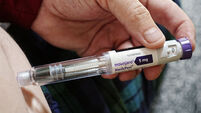Bad medicine: Profession’s image needs nursing back to good health
You don’t tell a conference of nurses that the nursing profession has a poor image. You certainly don’t tell them that you dread hearing that a nurse is going to come onto a radio programme, because you know she’s going to be moaning.
But that’s precisely what happened at last week’s Conference of the HSE South’s Nursing and Midwifery Planning and Development Unit. It wasn’t an external speaker who rubbished media contributions by nurses. It was one of their own. A senior one of their own, whose observations were supported by most of the audience, including a colleague who asked the ultimate gobsmacker question.
“What other profession can you think of,” she asked, “that is usually represented on media by the head of their trade union?”
She wasn’t taking a dig at Liam Doran, whose distinctive voice ably defends nursing interests on the airwaves. She was making a much more important point: we hear hospital consultants on radio all the time.
Maurice Nelligan, for decades, was the personification of expertise on cardiac surgery. John Crown is the current personification of expertise on oncology. When it comes to MRSA or other hospital bugs, Ed Smyth or Hilary Humphreys appear. At least two of yesterday’s newspapers carried features written by hospital consultants.
Finbarr Fitzpatrick, the man who’s headed up the consultants’ trade union (not that they’d call it a trade union) since God was a boy, gets wheeled out to indicate great sadness at the lack of progress in negotiation or conditional joy, when negotiations seem to be moving forward. Nobody expects, however, that Mr Fitzpatrick would ever personify, in media, the profession he represents. The consultants can raise issues, write about research, contribute on debates all by themselves. And they do.
Because consultants are experts in their fields, the names and phone numbers of the most accessible are in journalists’, producers’ and researchers’ little black books and little Blackberrys. The same is not true of nurses, despite the fact that nursing has taken a quantum leap in recent years and now requires third level qualification.
One of the reasons has to be the fact that nursing, in public communication terms, is a little like one of those plastic bottles of orange juice where the contents settle into two distinct halves: at the top an etiolated liquid, at the bottom a thicker version, requiring a good shake to homogenise the two. Except that a good shake would be irrelevant in the case of nursing. The top bit of nursing, right now, is made up of highly qualified, ambitious women who have moved into management. They’re in areas which have little direct contact with nursing. They may have started as nurses, but they’ve left nursing behind them.
Among the active nurses is a huge number who work shifts or who job-share in order to give themselves time for child-rearing.
The pattern of personal and career progress couldn’t be more different to that of surgeons and specialists, and the end result is a confused public image.
At the conference last week, fascinating papers were presented about different aspects of nursing.
One of them summarised research into how nurses make decisions and to what degree they access international research on the internet to inform those decisions.
But underlying the talk was a justified dissatisfaction with how nursing is perceived. Although the phraseology has changed, so that there’s more talk of care teams, the public understanding of what nursing is has not.
What emerged from the conference was an inchoate sense that some body — like, perhaps, the National Council for the Professional Development of Nursing and Midwifery — should address the issue of image and branding of this changing profession. Clearly part of that re-branding would be the establishment of competent, confident figures within nursing, who appear frequently in media, not to whinge about lack of money or resources, but to help the public rediscover nursing.
One model of approach was pioneered at an earlier point of huge change within the profession, by a woman with the good fortune to have a memorable name: Florence Nightingale. Nightingale is remembered as The Lady with the Lamp, compassionately doing her nocturnal tours of hospital wards in the Crimea filled with wounded British soldiers. In fact, Nightingale was an ambitious, driven, intolerant control-freak who did little in the way of mopping fevered brows because she was too busy introducing systems to what, up to that point, had been a largely unsystematic profession.
The Mercy sisters fell foul of Nightingale in the Crimea because their nursing priorities didn’t match hers. Evelyn Bolster’s history of the order’s involvement, published in the 1960s, paints a picture of Nightingale intimidating everybody around her, other than Mother Mary Francis Bridgeman, who headed up the Mercy group in Nightingale’s hospital.
Nightingale’s rules required that bandages be changed every day and dead or gangrened tissue scraped away. The Mercy sisters thought this was good practice — except for men who were evidently going to die within hours. They saw no point in subjecting dying men to excruciating pain, and so they breached the new rules.
They were soon on the boat home to Ireland. Florence Nightingale wasn’t much for consensus management. If you weren’t for her, you were agin her, and if you were agin her, you didn’t survive.
Her undeviating determination to put her own stamp on nursing, nonetheless, succeeded, not just because of her capacity to use vitriol, charm and manipulation in equal measure, but because she understood the importance of communication.
“Nightingale’s influence over public affairs was greatest between 1858 and 1872,” a recent history points out. “During this time she wrote one minor classic under her own name — the famous Notes on Nursing that earned her money she could find good uses for, and is still in print today.
Nightingale wrote speeches for cabinet ministers to deliver in parliament and endlessly drafted and redrafted regulations for various public bodies. She leaked information to key journalists to keep the public informed and clamouring for reform. She laboured over the construction of forms to be used in the collection of medical data.”
She had, in short, the genius for branding and re-positioning a profession which is now needed all over again. She communicated constantly and well, using every conduit open to her and wasting no time on irrelevancies. Even when those irrelevancies were raised by the monarch. So, when Queen Victoria, concerned about reports of the nasty smells in the Crimean Hospitals, wondered if she should send a crate of eau-de-cologne, the diplomat delivering the question got a blunt answer from Nightingale.
She didn’t quite tell him to tell the Queen where to stick the eau-de-cologne.
But she did say that a crate of gin would be much more welcome.














